Distinguished Critique: Millennium Review
Millennium is divided on which story it wants to tell, and as a result, the whole series wobbles on a weak foundation
—by Nathan on November 14, 2023—
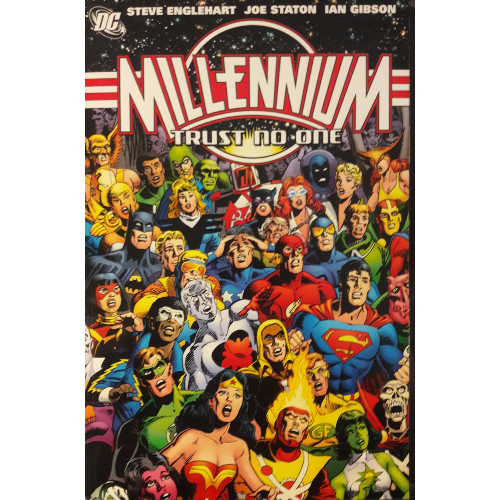
I’ve taken a dive into two of DC’s crossover arcs from the 1980s, the cosmic-crushing Crisis on Infinite Earths and the company’s first post-Crisis event, Legends. I’ve headed into both of these fairly obliviously, unaware of most of the tie-ins and unsure of how to draw a narrative between these stories. How did the aftermath of Crisis lead into Legends, if at all? I’m uncertain, save for that Crisis had affected DC history and continuity, creating a quasi-reboot. Gone was Wonder Woman’s history, instead gaining a new origin by George Perez. Superman received an update by John Byrne, as did Batman from Frank Miller and Green Lantern from Keith Giffen and Christopher Priest, as well as some other characters whose post-Crisis transformations I intend on unpacking at intervals.
Likewise, I am unaware of how Legends fed into this crossover event, Millennium. I’m not all too concerned, to be honest: I’m more interested in scoping out the story itself, casting aside tie-ins and miniseries and other contextual clues in favor of honing in on the central narrative…
…which, in this case, may be a mistake.
Millennium
Writer: Steve Englehart
Pencilers: Joe Staton
Inkers: Ian Gibson
Colorist: Carl Gafford
Letterers: Bob Lappan
Issues: Millennium #1-8
Publication Dates: January 1988-February 1988
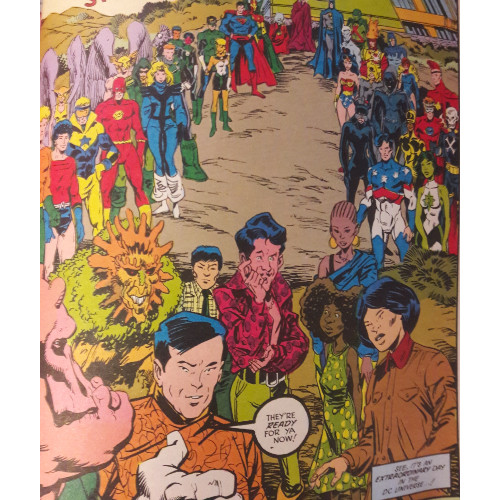
Reading Millennium, I was often reminded of Brian Michael Bendis' New Avengers.
New Avengers, starring an Avengers team formed shortly after the original team disbanded in the wake of the Scarlet Witch’s mental breakdown, followed a central plot which often incorporated elements from Marvel’s larger epics–Civil War, Secret Invasion, Dark Reign, Siege. Whether it’s because the Avengers were being hyped as Marvel’s premiere super-team, its roster (consisting of Captain America, Iron Man, Spider-Man, Wolverine, and others) naturally played significant roles in these crossovers, or Bendis was an architect in several of these larger narratives, New Avengers never felt subservient or sidelined by the precocious whims of "the story at large." I never felt like Bendis had to put his plans on the backburner to make room for tying into Marvel’s latest epic; in several arcs, New Avengers felt like a key component to these larger stories, despite being a tie-in to the principal event. If you were aware of the events themselves, you could easily see how New Avengers slotted itself into those crossovers
If, however, you only read New Avengers and were oblivious to the larger events, you’d be missing out. Bendis' most jarring moments occur when he haphazardly references events in other series rather than incorporating them fully, such as nods to arcs happening in Mighty Avengers which play partially into New Avengers. When this new team takes center stage, they feel integral. You would still need the central narrative or series, though, to make complete sense of the story. You can read Civil War without reading New Avengers and understand what’s going on; try the opposite…and you may be a little confused. This makes sense. New Avengers, though more significantly tethered to event series than its contemporaries, still becomes a tie-in when events are tossed into the mix.
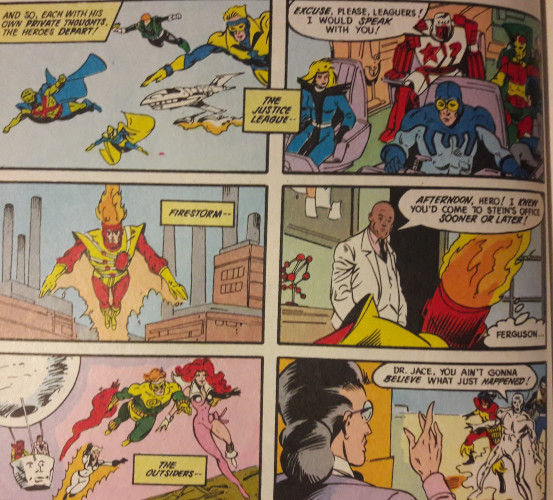
Reading Millennium feels like reading New Avengers without reading Civil War, Secret Invasion, or Siege. Here’s the problem: Millennium is the event. It’s the main series. It should not feel like a tie-in unto itself. Yet it does. I find that problematic.
To get the full scope of the story, the reader would have to pick up 45 issues, consisting of the eight-issue main series and a variety of tie-ins. No single volume collects the entire narrative, and I am not certain which volumes of series starring Wonder Woman, Legion of Superheroes, Firestorm, Batman, Superman, etc. contain all the individual issues necessary to flesh out the entire story (I do, coincidentally, own the Flash tie-in issues, but those belong in a volume left reviewed for another day). Even then, were all the available issues collected in different volumes, you would need to fork over a good deal of cash to possess them all, plus mentally align how all these different issues make up the bulk of the story.
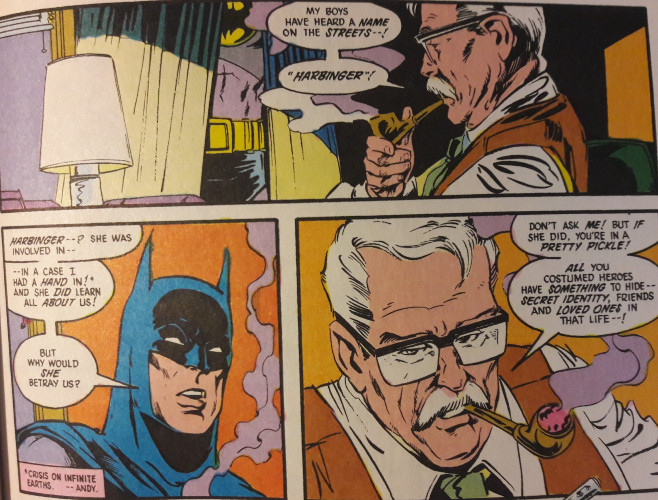
A reader should, I believe, understand the crux of Millennium simply by reading the series alone. And, in a way, this does happen: readers are treated to a secret invasion (no, not that one) where Manhunter agents have infiltrated Earth and plan to take control of the planet; Earth’s only hope is the combined might of its assembled heroes–some of whom may be traitors in disguise!–and a contingent of recently discovered metahumans whose only role is to become a hot new super-team and sell comics. You can see it in the title: Millennium. A new age, a new dawn, encapsulated by these new heroes. If Legends was a defense of the "old guard" and their post-Crisis viability, Millennium is the argument for new blood, despite the financial power of heroes like Batman, Superman, and Wonder Woman, who had all received facelifts in the wake of Crisis on Infinite Earths.
Much of the story focuses on these new characters, with the final issue giving them abilities and costumed identities before they go off into the unknown of their own title. The ploy, it appears, is to heavily showcase their potential. Steve Englehart, to his credit, crafts a racially and temperamentally diverse cast, some of whom are simply at odds with one another over their racial or political differences, others more capable of seeing the big picture. Tension skitters through the ranks even as a blue-skinned Guardian of the Universe and his Zamaronian companion gradually reveal to them their purpose.
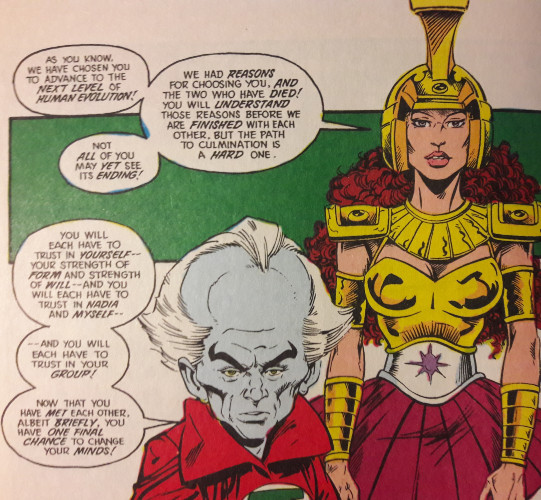
This stuff is fine. It’s perfectly serviceable, if not a tad bland. The tense moments are woven in-between a good deal of exposition espoused by the Guardian and Zamaronian, unraveling history and philosophy and speaking esoterically enough to make the Silver Surfer’s skin glow a shade of jealous pink. They talk…and talk…and just keep talking. Much is made of peace and unity, pulling in themes of racial tension and Cold War policies, which makes it hard to not feel like Millennium is somewhat dated.
Granted, the core concepts woven into the spoken words are relevant nowadays, but when one of your new characters is a white South African politician who’s consistently the slimiest, racist dude around, it’s hard not to find some of Englehart’s assertions as good-intentioned but blunt. He’s not as heavy-handed as Ostrander and Wein’s repetitive assertion about "legends" in the prior year’s titular crossover, but there’s no gray to wrestle with here. Slimy, racist South African guy is just a slimy racist, and though I’m darn certain there were and still are people who think and speak the way he does in this series, the guy just doesn’t let up, and his one-track mind becomes somewhat tiresome.
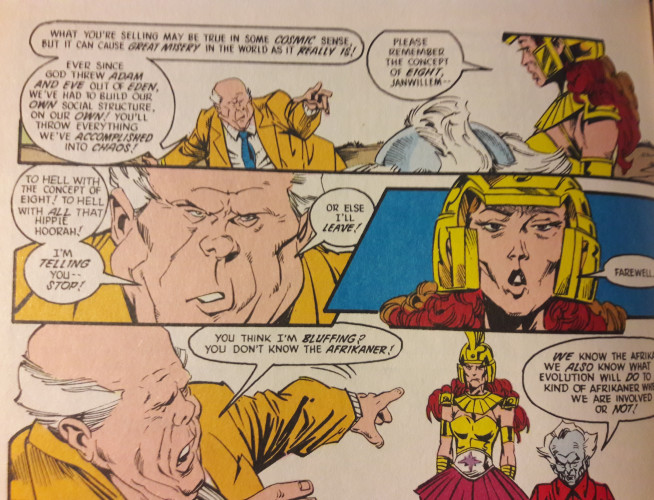
There is absolutely merit in utilizing social commentary and introducing diverse racial and political cast members, but there's also narrative logic to consider. I find it difficult to enjoy a story when messages are shoehorned in for the sake of preaching or an international cast is incorporated to just placate an audience or appear diverse on the surface, particularly when that cast adds little to the story outside of the color of their skin or their heritage, ethnicity, or cultural background. I want my characters to be close to real people, not labels, properly representative of their cultures and relatable to larger audiences.
Returning to the repetitive nature of Millennium, one line of dialogue is continually utilized dramatically: "No man escapes the Manhunters!" So proclaim the men-hunting aliens. The emphasis on this declaration is part of the problem with this series. Again, I’m assuming, given the widespread nature of tie-in material, all sorts of subplots involving the Manhunters abounded, allowing their invasion more deserved depth. Their threat is viable yet is treated as something for the aforementioned "old guard" to contend with, giving Millennium a bizarre duality between stomping alien menaces and introducing new metahumans. Because of this, the Manhunter menace is given little room to breathe other than to reveal they’ve already infiltrated Earth and fight pitched battles with our heroes. Yeah, these guys are powerful and duplicitous, and their scheme warrants merit, but their threat is largely constructed upon how we're intended to react to their oft-repeated threat. Am I supposed to be chilled by their declaration? I'm not, unfortunately. "No man" may escape the Manhunters, but my attention certainly slipped away somewhere back there, boys.
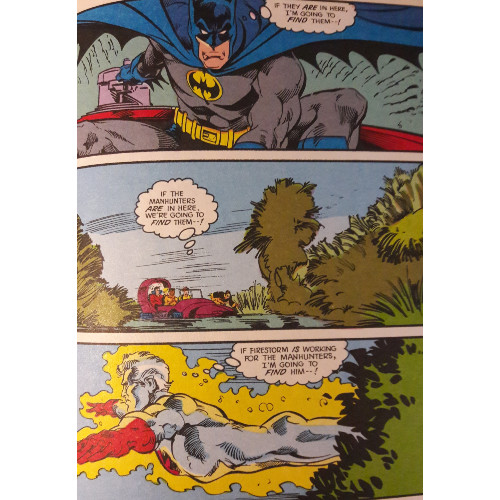
Genuinely engaging plot points–a traitor within the Justice League! A superhero’s parent replaced! An attack on a Manhunter settlement in the Louisiana bayou!–are glossed over or relegated to exposition. Read this month’s issue of Flash if you want to learn more! This is why Millennium feels like only a small portion of the larger story when it should feel deeper...especially for an eight-issue series! Milestones and important moments feel omitted or commented on briefly as opposed to being given the weight they deserve. Batman, last seen heading towards the bayou base at the end of one issue, pops up at a Green Lantern base at the start of the next issue. Some unresolved subplot surrounding Captain Atom seems inserted only to remind us he had his own book and whatever he’s wrestling with here warrants little more than a handful of lines.
Millennium is a house divided against itself, the racially diverse cast of newcomers at war with the alien invaders seeking to stake their claim to equal page space. I don’t know how often these new characters were used past their own series, and despite the initial appeal, they don’t appear to have had the longevity of other teams, such as the equally diverse yet far more engrossing X-Men. There are good intentions here, sewing seeds of representation. But those seeds are planted in dirt infested with a weedy, thorny other half, whose incomplete nature chokes much of the life out of any potential growth. The new dawn rises into a cloudy sky, the sun obscured, weak rays struggling to punch through and leaving only enough light to see dimly.